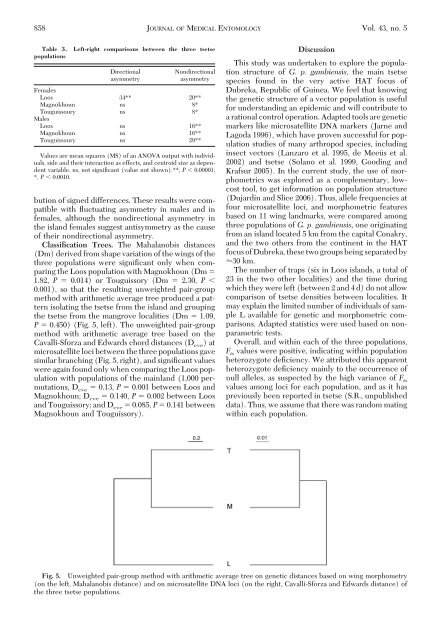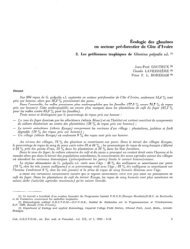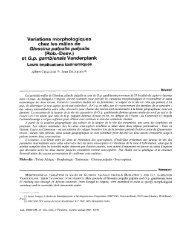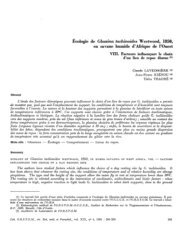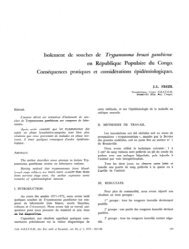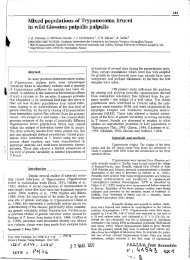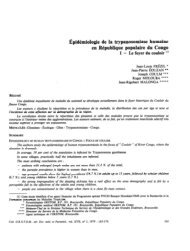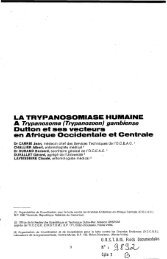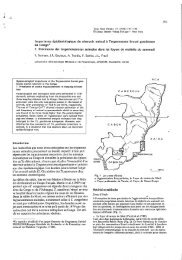Genetic and Morphometric Evidence for Population Isolation of ... - IRD
Genetic and Morphometric Evidence for Population Isolation of ... - IRD
Genetic and Morphometric Evidence for Population Isolation of ... - IRD
You also want an ePaper? Increase the reach of your titles
YUMPU automatically turns print PDFs into web optimized ePapers that Google loves.
858 JOURNAL OF MEDICAL ENTOMOLOGY Vol. 43, no. 5<br />
Table 3.<br />
populations<br />
Left-right comparisons between the three tsetse<br />
Directional<br />
asymmetry<br />
Nondirectional<br />
asymmetry<br />
Females<br />
Loos 34** 20**<br />
Magnokhoun ns 8*<br />
Touguissoury ns 8*<br />
Males<br />
Loos ns 16**<br />
Magnokhoun ns 16**<br />
Touguissoury ns 29**<br />
Values are mean squares (MS) <strong>of</strong> an ANOVA output with individuals,<br />
side <strong>and</strong> their interaction as effects, <strong>and</strong> centroid size as dependent<br />
variable. ns, not signiÞcant (value not shown).**, P 0.00001;<br />
*, P 0.0010.<br />
bution <strong>of</strong> signed differences. These results were compatible<br />
with ßuctuating asymmetry in males <strong>and</strong> in<br />
females, although the nondirectional asymmetry in<br />
the isl<strong>and</strong> females suggest antisymmetry as the cause<br />
<strong>of</strong> their nondirectional asymmetry.<br />
Classification Trees. The Mahalanobis distances<br />
(Dm) derived from shape variation <strong>of</strong> the wings <strong>of</strong> the<br />
three populations were signiÞcant only when comparing<br />
the Loos population with Magnokhoun (Dm <br />
1.82, P 0.014) or Touguissory (Dm 2.30, P <br />
0.001), so that the resulting unweighted pair-group<br />
method with arithmetic average tree produced a pattern<br />
isolating the tsetse from the isl<strong>and</strong> <strong>and</strong> grouping<br />
the tsetse from the mangrove localities (Dm 1.09,<br />
P 0.450) (Fig. 5, left). The unweighted pair-group<br />
method with arithmetic average tree based on the<br />
Cavalli-S<strong>for</strong>za <strong>and</strong> Edwards chord distances (D cve )at<br />
microsatellite loci between the three populations gave<br />
similar branching (Fig. 5, right), <strong>and</strong> signiÞcant values<br />
were again found only when comparing the Loos population<br />
with populations <strong>of</strong> the mainl<strong>and</strong> (1,000 permutations,<br />
D cve 0.13, P 0.001 between Loos <strong>and</strong><br />
Magnokhoun; D cve 0.140, P 0.002 between Loos<br />
<strong>and</strong> Touguissory; <strong>and</strong> D cve 0.085, P 0.141 between<br />
Magnokhoun <strong>and</strong> Touguissory).<br />
Discussion<br />
This study was undertaken to explore the population<br />
structure <strong>of</strong> G. p. gambiensis, the main tsetse<br />
species found in the very active HAT focus <strong>of</strong><br />
Dubreka, Republic <strong>of</strong> Guinea. We feel that knowing<br />
the genetic structure <strong>of</strong> a vector population is useful<br />
<strong>for</strong> underst<strong>and</strong>ing an epidemic <strong>and</strong> will contribute to<br />
a rational control operation. Adapted tools are genetic<br />
markers like microsatellite DNA markers (Jarne <strong>and</strong><br />
Lagoda 1996), which have proven successful <strong>for</strong> population<br />
studies <strong>of</strong> many arthropod species, including<br />
insect vectors (Lanzaro et al. 1995, de Meeüs etal.<br />
2002) <strong>and</strong> tsetse (Solano et al. 1999, Gooding <strong>and</strong><br />
Krafsur 2005). In the current study, the use <strong>of</strong> morphometrics<br />
was explored as a complementary, lowcost<br />
tool, to get in<strong>for</strong>mation on population structure<br />
(Dujardin <strong>and</strong> Slice 2006). Thus, allele frequencies at<br />
four microsatellite loci, <strong>and</strong> morphometric features<br />
based on 11 wing l<strong>and</strong>marks, were compared among<br />
three populations <strong>of</strong> G. p. gambiensis, one originating<br />
from an isl<strong>and</strong> located 5 km from the capital Conakry,<br />
<strong>and</strong> the two others from the continent in the HAT<br />
focus <strong>of</strong> Dubreka, these two groups being separated by<br />
30 km.<br />
The number <strong>of</strong> traps (six in Loos isl<strong>and</strong>s, a total <strong>of</strong><br />
23 in the two other localities) <strong>and</strong> the time during<br />
which they were left (between 2 <strong>and</strong> 4 d) do not allow<br />
comparison <strong>of</strong> tsetse densities between localities. It<br />
may explain the limited number <strong>of</strong> individuals <strong>of</strong> sample<br />
L available <strong>for</strong> genetic <strong>and</strong> morphometric comparisons.<br />
Adapted statistics were used based on nonparametric<br />
tests.<br />
Overall, <strong>and</strong> within each <strong>of</strong> the three populations,<br />
F is values were positive, indicating within population<br />
heterozygote deÞciency. We attributed this apparent<br />
heterozygote deÞciency mainly to the occurrence <strong>of</strong><br />
null alleles, as suspected by the high variance <strong>of</strong> F is<br />
values among loci <strong>for</strong> each population, <strong>and</strong> as it has<br />
previously been reported in tsetse (S.R., unpublished<br />
data). Thus, we assume that there was r<strong>and</strong>om mating<br />
within each population.<br />
Fig. 5. Unweighted pair-group method with arithmetic average tree on genetic distances based on wing morphometry<br />
(on the left, Mahalanobis distance) <strong>and</strong> on microsatellite DNA loci (on the right, Cavalli-S<strong>for</strong>za <strong>and</strong> Edwards distance) <strong>of</strong><br />
the three tsetse populations.


